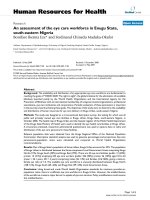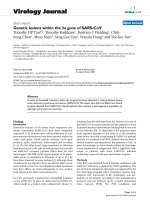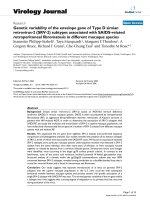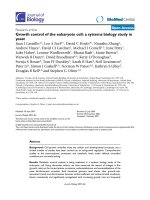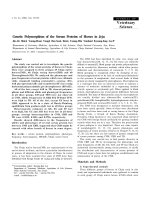Báo cáo sinh học: "Genetic variations of the porcine PRKAG3 gene in Chinese indigenous pig breeds" pot
Bạn đang xem bản rút gọn của tài liệu. Xem và tải ngay bản đầy đủ của tài liệu tại đây (358.6 KB, 6 trang )
Genet. Sel. Evol. 36 (2004) 481–486 481
c
INRA, EDP Sciences, 2004
DOI: 10.1051/gse:2004012
Note
Genetic variations of the porcine PRKAG3
gene in Chinese indigenous pig breeds
Lu-Sheng H
∗
, Jun-Wu M,JunR, Neng-Shui D,
Yuan-Mei G, Hua-Shui A,LinL,Li-HuaZ,
Cong-Ying C
Key Laboratory for Animal Biotechnology of Jiangxi Province and the Ministry of Agriculture
of China, Jiangxi Agricultural University, Nanchang, 330045, P.R. China
(Received 31 October 2003; accepted 25 March 2004)
Abstract – Four missense substitutions (T30N, G52S, V199I and R200Q) in the porcine
PRKAG3 gene were considered as the likely candidate loci affecting meat quality. In this study,
the R200Q substitution was investigated in a sample of 62 individuals from Hampshire, Chinese
Min and Erhualian pigs, and the genetic variations of T30N, G52S and V199I substitutions were
detected in 1505 individuals from 21 Chinese indigenous breeds, 5 Western commercial pig
breeds, and the wild pig. Allele 200R was fixed in Chinese Min and Erhualian pigs. Haplotypes
II-QQ and IV-QQ were not observed in the Hampshire population, supporting the hypothesis
that allele 200Q is tightly linked with allele 199V. Significant differences in allele frequencies
of the three substitutions (T30N, G52S and V199I) between Chinese indigenous pigs and West-
ern commercial pigs were observed. Obvious high frequencies of the “favorable” alleles 30T
and 52G in terms of meat quality were detected in Chinese indigenous pigs, which are well
known for high meat quality. However, the frequency of the “favorable” allele 199I,whichwas
reported to have a greater effect on meat quality in comparison with 30T and 52G,wasvery
low in all of the Chinese indigenous pigs except for the Min pig. The reasons accounting for
this discrepancy remain to be addressed. The presence of the three substitutions in purebred
Chinese Tibetan pigs indicates that the three substitutions were ancestral mutations. A novel
A/G substitution at position 51 in exon 1 was identified. The results suggest that further studies
are required to investigate the associations of these substitutions in the PRKAG3 gene with meat
quality of Chinese indigenous pigs, and to uncover other polymorphisms in the PRKAG3 gene
with potential effects on meat quality in Chinese indigenous pigs.
pig / PRKAG3 gene / meat quality
1. INTRODUCTION
The protein kinase adenosine monophosphate-activated γ3-subunit
(PRKAG3) gene encodes the muscle specific isoform of the regulatory γ3
∗
Corresponding author:
482 L.S. Huang et al.
subunit of adenosine monophosphate activated protein kinase (AMPK),
which plays a key role in regulating energy homeostasis in eukaryotes.
A nonconserved substitution (R200Q)inthePRKAG3 gene was initially
characterized in Hampshire pigs [6], resulting in an approximate 70% increase
in muscle glycogen content with large effects on meat quality and processing
yields [2,3]. Three additional economically important missense substitutions
(T30N, G52S and V199I) in the porcine PRKAG3 gene were recently identified
with additive effects on the glycogen content in muscle and meat quality
traits [1]. The PRKAG3 gene was therefore supposed to be a functional
gene significantly affecting meat quality traits in pigs. China has abundant
indigenous pig breeds that are well known for high meat quality. Here we
report on the genetic variations of four missense substitutions (T30N, G52S,
V199I and R200Q)inthePRKAG3 gene in Chinese indigenous pigs in order
to provide new evidence of the effects of the PRKAG3 gene on meat quality.
2. MATERIALS AND METHODS
2.1. Animals
Three single nucleotide polymorphisms (SNP) of the porcine PRKAG3 gene
(T30N, G52S and V199I) were genotyped using 1505 individuals from 21 Chi-
nese indigenous pig breeds, 5 Western commercial pig breeds and wild pigs
(Tab. I). Samples were chosen avoiding full sib animals. Allele frequencies
at the R200Q mutation site were estimated in 37 purebred unrelated Hamp-
shire individuals, 13 unrelated Min pigs and 12 unrelated Erhualian pigs.
SNP screening was performed using 18 founder animals (2 White Duroc
and 16 Chinese Erhualian) of a three-generation intercross between White
Duroc × Chinese Erhualian. Genomic DNA were isolated from ear tissues by
phenol/chloroform extraction [4].
2.2. SNP genotyping
PCR-HphI (forward: 5’-ATG AGC TTC CTA GAG CAA GGA G-3’; re-
verse: 5’-GGC TGC ATG ATG TTA TGT GCC T-3’) and PCR-BsaHI/BsrBI
(forward: 5’-GGA GCA AAT GTG CAG ACA AG-3’; reverse: 5’- CCC ACG
AAG CTC TGC TTC TT-3’) were adopted to detect G52S, V199I and R200Q
substitutions, respectively [1]. PCR primers (forward: 5’-CAT CCC GAG CTG
TAA CCA CC-3’; reverse: 5’- GCC TTG AAC TCA CCT TCC CT-3’) were
designed and a PCR-StyI approach was taken to detect T30N substitution.
PCR reactions were performed in a PTC100 thermocycler (MJ Research,
Variations of porcine PRKAG3 gene 483
Waltham, USA) in a final volume of 15 µL containing 50 ng of porcine ge-
nomic DNA, 1.5 mM MgCl
2
, 0.125 mM of each dNTP, 0.3 µM of each primer
and 1 U Taq DNA polymerase with 10 × PCR buffer (MBI, Shanghai, China).
PCR profiles were 35 cycles of 94
◦
C for 30 s, 56∼59
◦
C for 40 s and 72
◦
C
for 30 s with an initial denaturation at 94
◦
C for 6 min and a final extension
at 72
◦
C for 5 min. PCR products were digested with 2 U restriction enzymes
at 37
◦
C for 12 h, and the restriction fragments were separated on 4% agarose
gels stained with ethidium bromide.
2.3. DNA sequencing and SNP identification
PCR products representing different genotypes at the four PRKAG3 SNP
loci were purified using a QIAquick PCR Purification Kit (QIAGEN, Hilden,
Germany), and were bi-directionally sequenced with the respective PCR
primers using the ABI PRISM
BigDye
TM
Terminator Cycle Sequencing Kit
(v3.0) and an ABI PRISM
3100 Genetic Analyzer (Applied Biosystems,
Foster City, USA). The sequence identity was compared by the Gapped
BLAST program (), and the sequences of 18 founder
animals were aligned by the application of the program SeqMan (DNAStar
software package, ) to identify the putative SNP.
3. RESULTS AND DISCUSSIONS
3.1. T30N, G52S and V199I substitutions
Allele frequencies at the T30N, G52S and V199I polymorphic loci in 21
Chinese indigenous pigs, 5 Western commercial pigs and the wild pig are
summarized in Table I. Chinese indigenous pig breeds belonging to the same
ecotype had more similar allele frequency distribution. Western commercial
pigs had higher polymorphism information content (PIC) at the three SNP loci
compared with most of the Chinese indigenous pigs. The differences of allele
frequencies between most of the Chinese indigenous pigs and Western com-
mercial pigs were significant (P < 0.05, data not shown). The genetic varia-
tions at the three SNP loci in Landrace, Large White and Duroc studied here
were similar to those reported previously [1], although some tiny deviations
were observed, presumably due to the smaller sample size in this study.
The 30T and 52G alleles were reported to be favorable in terms of meat
quality [1]. As expected, the 30T and 52G alleles were the predominant alleles
484 L.S. Huang et al.
Table I. Allele frequencies of the T30N, G52S and V199I substitutions in the PRKAG3
gene in 27 pig breeds.
Group 1 refers to western commercial pig breeds and Group 8 refers to the Chinese wild pig.
Group 2, 3, 4, 5, 6 and 7 are Chinese indigenous pig breeds which were classified into six
ecotypes including the Northern China type, the Southern China type, the Low Yangtze River
Basin Type, the Central China type, the Southeastern China type and the High Plateau type
according to their appearance, origin, productive characteristics and geographical distribution.
Variations of porcine PRKAG3 gene 485
in all Chinese indigenous pigs, which was consistent with the fact that Chinese
indigenous pigs generally have flavorful meat quality [5].
Amongst the T30N, G52S and V199I substitutions, the largest effects on
meat quality were obtained with the V199I substitution with the 199I allele
being the favorable allele for high meat quality in the association study [1].
A high frequency of the 199I allele was observed in Berkshire pigs which are
known for good meat quality in Western commercial pigs [1]. Surprisingly,
the frequencies of the favorable allele 199I were very low in all of the Chi-
nese indigenous pigs except for Min pigs. The explanations for the discrep-
ancy might be the following: (1) the effects of V199I substitution on the meat
quality of Chinese indigenous pigs are different from those of Western com-
mercial pigs; (2) other unrevealed substitutions in the PRKAG3 gene or other
functional genes with significant favorable effects in meat quality exist in Chi-
nese indigenous pigs, which ameliorate the negative effects of the 199V allele
in terms of meat quality in Chinese indigenous pigs. Further SNP screening
and identification of the porcine PRKAG3 gene are worthwhile.
All three substitutions were observed in Chinese Tibetan pigs. Few exotic
pig breeds have been introduced into the Qinghai-Tibet plateau, the habitat
of Chinese Tibetan pigs, because of geographical isolation. The existence
of T30N, G52S and V199I substitutions in purebred Chinese Tibetan pigs
indicates that the three substitutions were ancestral mutations.
Berkshire pigs were initially developed in Britain in the middle of the nine-
teenth century by crossing local pigs in England (the basic Berkshire stock)
with Siamese and Chinese Guangdong spotted pigs, which were introduced
into Britain in the 1770s [5]. The 199I allele was not found in the 57 Guang-
dong spotted pigs, indicating that tracing the high frequency of the 199I allele
in Berkshire pigs probably originated from local pigs in England or Siamese
pigs.
3.2. R200Q substitution
The R200Q substitution in the PRKAG3 gene was shown to be a causative
mutation underlying the large differences in meat quality and processing yield
in Hampshire pigs [6]. The allele frequencies of 200R and 200Q in the Hamp-
shire population in this study were 65% and 35%, respectively (Tab. I). The
ratio of RN
−
carriers (RQ and QQ individuals) was 57%, which was less than
that of 86% evaluated by a glycolytic potential in American Hampshire popu-
lations [7]. The II-QQ and IV-QQ haplotypes were not found in the Hampshire
population in this study (data not shown), supporting the hypothesis that 200Q
486 L.S. Huang et al.
is tightly linked with 199V [1]. No 200Q allele was present in the Chinese Min
and Erhualian pigs, consistent with the fact that the 200Q allele is observed
mainly in Hampshire pigs [1,6].
3.3. SNP identification
A novel SNP, A/G transversion at position 51 in exon 1, was identified
in the PCR1 amplicon; the synonymous mutation does not alter the encod-
ing amino acid. The A/G substitution was verified by the alignment of two
porcine PRKAG3 gene sequences deposited in the database (Genbank acces-
sion no. AF214521 and AX398341.1, data not shown).
ACKNOWLEDGEMENTS
This study was financially supported by the National Natural Science Foun-
dation of China (30060058) and the National 973 project 2003CCA00600.
REFERENCES
[1] Ciobanu D., Bastiaansen J., Malek M., Helm J., Woollard J., Plastow G.,
Rothschild M., Evidence for new alleles in the protein kinase adenosine
monophosphate-activated γ3-subunit gene associated with low glycogen con-
tent in pig skeletal muscle and improved meat quality, Genetics 159 (2001)
1151–1162.
[2] Gariépy C., Godbout D., Fernandez X., Talmant A., Houde A., The effect of RN
gene on yields and quality of extended cooked cured hams, Meat Science 52
(1999) 57–64.
[3] Le Roy P., Elsen J.M., Caritez J.C., Talmant A., Juin H., Sellier P., Monin G.,
Comparison between the three porcine RN genotypes for growth, carcass compo-
sition and meat quality traits, Genet. Sel. Evol. 32 (2000) 165–186.
[4] Lu S.D., Current protocols for molecular biology, 2nd edn, Higher Education
Press, China, 1999.
[5] Lu Z.X., Guo C.J., The theory and practice of current pork production, Chinese
Agricultural Science Press, China, 1995.
[6] Milan D., Jeon J.T., Looft C., Amarger V., Robic A., Thelander M., Rogel-
Gaillard C., Paul S., Iannuccelli N., Rask L., Ronne H., Lundstrom K., Reinsch N.,
Gellin J., Kalm E., Roy P.L., Chardon P., Andersson L., A mutation in PRKAG3
associated with excess glycogen content in pig skeletal muscle, Science 288
(2000) 1248–1251.
[7] Miller K.D., Ellis M., Mckeith F.K., Bidner B.S., Meisinger D.J., Frequency of
the Redement Napole RN
−
allele in a population of American Hampshire pigs, J.
Anim. Sci. 78 (2000) 1811–1815.
